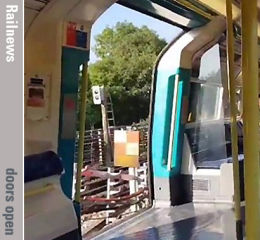Posted 11th July 2019 | 4 Comments
Open tube train doors incident may have been caused by stress

@roryfergusbrown
A COMBINATION of fatigue and low blood sugar may have been behind the failure of an Underground train driver to make sure all the doors were closed before he left a station.
The Rail Accident Investigation Branch has also said poor training could have been another factor.
The incident happened on 1 September last year on a northbound Jubilee Line train. It left Finchley Road with ten sets of double doors open, and achieved a speed of about 60km/h between Finchley Road and the next station, West Hampstead.
None of the 30 passengers on board were hurt.
The RAIB has made four recommendations, including greater use of simulators during driver training.
RAIB chief inspector Simon French said: ‘This very unusual incident highlights the stresses which Underground train operators can be subject to when something goes wrong. A technical fault which developed suddenly and without warning created a situation which the train operator had never encountered before. His attempts to solve the problem led him to isolate a safety circuit and move off without checking that the train doors were properly closed. In fact, ten sets of doors along one side of the train were wide open as the train ran the full distance to the next station. It is fortunate that there was no-one close to the doors at the time.
‘The rise of automatic operation has greatly improved the reliability of train services, but it has reduced the amount of engagement the train operator has with the on-train systems and equipment, which have become ever more complex. It is rare that an operator has to deal with a technical problem in service and understandable that, as in this case, they may sometimes be unsure of what steps to take. It is therefore important that operators are given the best possible training, and that the effectiveness of their response to problems is assessed as part of the company’s competence management system.’
Transport for London said safety was its ‘top priority’, and London Underground has already taken action in response to the RAIB’s findings.
TfL director of health, safety and environment Jill Collis said: ‘We will continue to review our procedures to ensure we consider all the recommendations made in the RAIB report, and continue to work to ensure that the Tube network is as safe as possible.’
Reader Comments:
Views expressed in submitted comments are that of the author, and not necessarily shared by Railnews.

Kai Chung, Kent
It is clearly a Design Fault of the Train, the train in question was originally designed around 1989/1990 time, hence the very 1980's interior colour theme internally, dating from the 1980's. A major design fault, as the automatic system should have cut out once the doors were isolated, forcing the Operator to use Slow Speed Restricted Manual in order to move the train to the next station, as is the case with all other London Underground automatically driven trains. Don't blame the Operator for this. It's the Train Manufacturer who should appear in court for a serious latent design fault which has remained unnoticed for three decades.
Andrew Gwilt, Benfleet Essex
Must be very scary for the passengers to see the doors left wide open whilst the train was moving and the driver has forgotten to close the doors. Which I do think it was to do with the driver experiencing fatigue as a result of working long hours without no rest.
Sam Green, York
But surely the door interlocking would prevent the train drawing power if the driver tried to depart with the doors open.So the fault lies within the train`s safety systems!
[See my answer below. The interlocking circuit had been isolated.--Ed.]
jak jaye, surrey
Sorry to ask the obvious, the trains should have a automatic override that prevents them from starting with the doors open,or am i missing something?
[Simon French, quoted in our story, explains what happened: "His attempts to solve the problem led him to isolate a safety circuit and move off without checking". So the automatic protection was isolated.--Ed.]